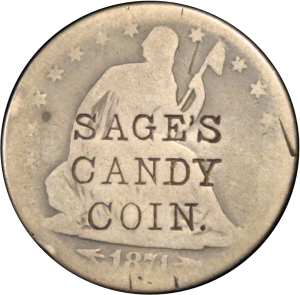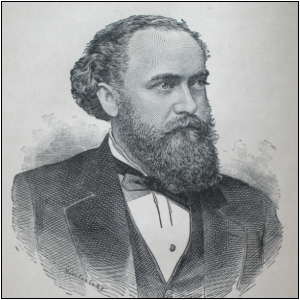Sage’s Candy Coin
 One counterstamp that has piqued my interest of late is the mysterious SAGES CANDY COIN mark found on some examples of 1870’s vintage, high-denomination U.S. coins. It was once believed that this counterstamp might be the subject of a 19th century confection related promotion. The odd thing is that this mark is found on quarters, half dollars and Trade Dollars making this a truly generous promotion for that era.
One counterstamp that has piqued my interest of late is the mysterious SAGES CANDY COIN mark found on some examples of 1870’s vintage, high-denomination U.S. coins. It was once believed that this counterstamp might be the subject of a 19th century confection related promotion. The odd thing is that this mark is found on quarters, half dollars and Trade Dollars making this a truly generous promotion for that era.
In the last five years a more precise theory has come to light regarding the origins of the Sage counterstamp. It seems that Sage’s “Candy” was the product of one Dr. Ray Vaughn Pierce using the pseudonym of Dr. Sage.
 Ray Vaughn Pierce was born in 1840 in Stark, New York. In his early twenties he set up practice in Titusville, Pennsylvania. An early claim was that he had graduated from the Philadelphia University of Medicine and Surgery. More recently, however, Ohio University Medical Historian Norman Gevitz dispelled this particular laurel (his exact words: “Undoubtedly, the diploma was purchased”). A second boast was an earned degree from the Eclectic Medical College in Cincinnati, Ohio. Regardless of his scholastic accomplishments it is known that he practiced traditional medicine in Titusville for five years, after which he moved to Buffalo to continue his practice in 1867.
Ray Vaughn Pierce was born in 1840 in Stark, New York. In his early twenties he set up practice in Titusville, Pennsylvania. An early claim was that he had graduated from the Philadelphia University of Medicine and Surgery. More recently, however, Ohio University Medical Historian Norman Gevitz dispelled this particular laurel (his exact words: “Undoubtedly, the diploma was purchased”). A second boast was an earned degree from the Eclectic Medical College in Cincinnati, Ohio. Regardless of his scholastic accomplishments it is known that he practiced traditional medicine in Titusville for five years, after which he moved to Buffalo to continue his practice in 1867.
It was in Buffalo that he began to expand his business into the manufacture and sale of proprietary medicine. This was commonplace in the late 19th century as there was little federal regulation in this field. Legitimate and illegitimate doctors alike produced a variety of elixirs, oils, salves, tablets, blood purifiers and an entire family of bitters billed as cure-alls.
In their day, this was a viable substitute for having access to medical facilities, especially for customers in rural areas. Many of these medical charlatans would purport that owning a bottle of their latest concoction was akin to ‘having a doctor in the house.’ It was from these unfounded expectations that the whole idea of the polished and fast talking snake-oil salesman was born. Certain proprietors of these panacea had larger than life personalities and were sure to draw a crowd. They were not above using shills in the audience to reinforce claims that their potent tonic had miraculously cured every ailment that once maligned them.
Advertising of these miracle medicines was predominantly word of mouth mixed with some newspaper ads, the occasional painted barnside or, relevant to numismatists, a counterstamped coin. Dr. Pierce, and sometimes his alter ego Dr. Sage, would utilize all of the popular means of advertising of the day for his Golden Medical Discovery, Catarrh Cure, Pleasant Purgative Pellets, Nasal Douche, Extract of Smartweed and an entire line of products aimed specifically at diseases of women.
While on the topic of women, one has to wonder why this particular demographic was the focus of so many of Dr. Pierce’s products. Well, the good doctor viewed women as favorably as most of his contemporaries in the medical field did; which is to say he looked down on them as irresponsible children who needed to be cared for and watched after. Because they were misunderstood, women in this era were especially vulnerable to misdiagnosis and inadequate treatment. A common belief was that their ailments were caused by their sexual organs. In many cases this led to highly experimental and sometimes lethal treatments for women.
Dr. Pierce’s attitude towards women and their ability to take care of themselves responsibly may have been conventional but judged by the scrutiny of history it was entirely chauvinistic. He held the belief that women could not help other women with their medical concerns even if she had already experienced a similar condition. This was chalked up to the lack of loyalty and discretion that the fairer sex possessed, or so it was believed. This sexism did not skip a generation it seems as Dr. Pierce’s son, Valentine Mott Pierce, published the ‘Dream Book — Bridal Superstitions’ for women in 1922.
In addition to hawking his famous line of potions Dr. Pierce was also the proprietor and chief consultant at the Invalid’s Hotel and Surgical Institute in Buffalo, New York which staffed over a dozen physicians. The facility was state-of-the-art complete with electric elevators, ozone machines, and power generators.
He was also publisher of the Common Sense Medical Advisor which consisted of 1006 pages and over a twenty year span sold 2 million copies in North America and Europe. Copies of the guide book could be requested by sending 31 cents in stamps for a cloth-bound edition. The publication primarily consisted of Dr. Pierce’s attempt to defend against accusations that his elixirs contained opium or alcohol and his popular boast that he would pay $500 as a reward to any individual uncured by a bottle of his good stuff. The balance of the ink was devoted to sycophantic praise from his devotees **As a side note: the Massachusetts State Board of Health did find traces of opium in Dr. Pierce’s Favorite Prescription in 1882 despite the doctor’s plea to the contrary.
IN THE DOCTOR’S OWN WORDS
(from the pages of the Common Sense Medical Advisor)
Dr. Pierce’s “Golden Medical Discovery,” or Alterative Extract. This compound is a highly nutritive and tonic preparation, combining the remedial properties of the best vegetable alteratives at present known to the medical profession. In perfecting this alterative compound, and likewise other standard preparations of medicine, we have made an outlay of many thousand dollars for chemical apparatus, and special machinery by the aid of which these remedies have been brought to their present perfection. Great pains are taken to obtain the materials at the right season of the year, properly cured so that none of their remedial qualities may be impaired. We, therefore, can with great confidence recommend Dr. Pierce’s “Golden Medical Discovery” as one of the best preparations of the alterative class. Like all others of this type, its action is insensible, producing gradual changes, arousing the excretory glands to remove morbid materials, and at the same time toning the secretory organs. The manufacture of this compound is under the special supervision of a competent chemist and pharmaceutist, and it is now put up in bottles wrapped with full directions for its use. We can confidently recommend this compound whenever an alterative is required to cleanse the blood, tone the system, increase its nutrition, and establish a healthy condition. For these reasons we shall often advise its employment.
Dr. Pierce’s Pleasant Purgative Pellets. These pellets combine the pure, concentrated, active principles of several vegetable alteratives, and the result is, that within the small compass of a few grains he has most happily blended and chemically condensed these properties, so that their action upon the animal economy is sanative and universal. They awaken the latent powers, quicken the tardy functions, check morbid deposits, dissolve hard concretions, remove obstructions, promote depuration, harmonize and restore the functions, equalize the circulation, and encourage the action of the nervous system. They stimulate the glands, increase the peristaltic movement of the intestines, tone the nutritive processes, while aiding in evacuating the bowels. All this they accomplish without corroding the tissues or vitiating the fluids. Their assistance is genial, helping the system to expel worn out materials, which would become noxious if retained. Having expended their remedial powers upon the various functions of the body, they are themselves expelled along with other waste matter, leaving behind them no traces of irritation. This cannot be said of mercurials, or of other harsh, mineral alternatives. These Pellets may be safely employed when the system is feeble, frail, and delicate, by giving them in less quantities. Dose—As an alterative, only one or two Pellets should be taken daily.
A DEBT OF GRATITUDE
Gentlemen — Some ten years ago I suffered untold agony from chronic nasal catarrh. My family physician gave me up as incurable, and said I must die. At this time I weighed 110 pounds. My case was such a bad one, that every day, towards sunset, my voice would become so hoarse I could barely speak above a whisper. In the morning my coughing and clearing of my throat would almost strangle me. By the use of Dr. Sage’s Catarrh Remedy in three months I was a well man; the cure has been permanent, and I now weigh 148 pounds.
Yours truly,
Prof. W. Hausner
Ithaca, Tompkins Co., NY
In the name of full disclosure, Hausner was a famous Mesmerist who published works on animal magnetism and held similar misogynistic views towards women as Pierce. Later in life Ray Vaughn Pierce served as a State Senator from 1877 to 1879 and then a short stint as a Congressman from his district until 1880. It is rumored that President James A. Garfield once commented that Pierce was one of the finest men he had ever known and spoke favorably towards the medical empire that Pierce helped to create. Whether he was a medical professional or a huckster preying on the ill-informed, the fact remained that Dr. Sage made appearances in almost everyone’s medicine cabinet with his line of products selling well into the 1970’s.
The man at the center of our counterstamp mystery, Dr. Ray Vaughn Pierce died at his home on St. Vincent Island, Florida on February 4, 1914. His aforementioned son, Valentine Mott Pierce continued to publish pseudo-medical journals in the family tradition until 1942. Interestingly enough, the Florida property today is home to a national wildlife refuge with many animals flourishing that were nearly extinct one hundred years ago. The elder Dr. Pierce had the foresight to bring Sambar deer from the Bronx Zoo to St. Vincent Island. The marsh-like habitat is similar to that of Asia where Sambar are native and today more than 200 Sambar deer roam the former Pierce homestead.
Hopefully, you will reflect on this man and his interesting life the next time you see a SAGE’S CANDY COIN counterstamp. I am sure that I will.
— Greg Capps



